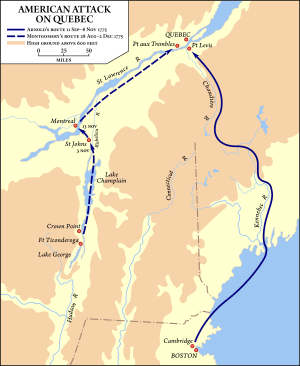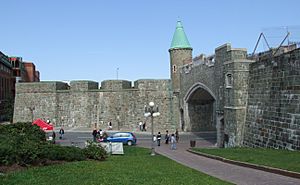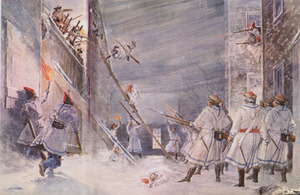Battle of Quebec (1775) facts for kids
Quick facts for kids Battle of Quebec |
|||||||
|---|---|---|---|---|---|---|---|
| Part of the American Revolutionary War | |||||||
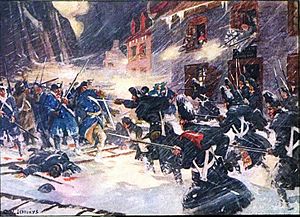 British and Canadian forces attacking Arnold's column in the Sault-au-Matelot, Charles William Jefferys |
|||||||
|
|||||||
| Belligerents | |||||||
| Commanders and leaders | |||||||
| Strength | |||||||
| 1,800 | 1,200 | ||||||
| Casualties and losses | |||||||
| 19 killed and wounded | 84 killed and wounded 431 captured |
||||||
The Battle of Quebec was a major fight during the American Revolutionary War. It happened on December 31, 1775, in Quebec City, which was then part of British Canada. American forces, called the Continental Army, attacked the city but were defeated by the British defenders.
This battle was a big loss for the Americans. Their leader, General Richard Montgomery, was killed. Another important general, Benedict Arnold, was wounded. Many American soldiers were captured, including Daniel Morgan and over 400 others. The British, led by Governor General Guy Carleton, had very few casualties.
Montgomery's army had already captured Montreal in November. Arnold's men joined them after a very difficult journey through the wilderness. Governor Carleton had escaped from Montreal to Quebec City, which was the Americans' next target. He quickly got more soldiers to help defend the city.
Montgomery decided to attack on New Year's Eve during a snowstorm. He hoped the storm would hide his troops. His plan was for two groups, one led by him and one by Arnold, to meet in the lower part of the city. Then, they would climb the walls to the upper city. But things went wrong. Montgomery was killed early on, and Arnold was wounded. Daniel Morgan took over Arnold's group but got trapped and had to surrender. The Americans tried to block the city for a while, but British help arrived in the spring, and the Americans had to leave.
Contents
Why the Americans Invaded Canada
The American Revolutionary War started in April 1775. Soon after, American forces captured Fort Ticonderoga. This made both the British and Americans think about invading Canada. The Americans wanted to stop the British from using Canada as a base to attack New England and New York.

American leaders like Benedict Arnold and Ethan Allen believed that British forces in Canada were weak. They also thought that the French-speaking people of Quebec, called Canadiens, would welcome the Americans as liberators. Many Canadiens were tenant farmers, known as habitants, and the Americans thought they would want to be free from their old system of land ownership. However, most habitants just wanted to stay neutral.
The American plan was a two-part attack. One group, led by General Philip Schuyler (later by Richard Montgomery), would go through Lake Champlain and the Richelieu River to take Montreal. The other group, led by Benedict Arnold, would march through the wilderness of Maine to Quebec City. General George Washington approved Arnold's risky journey.
In September 1775, the American army moved into Quebec. Montgomery's forces captured Montreal on November 13. Arnold's group, about 1,100 men, started their journey from Massachusetts.
Many Americans hoped the French Catholic Canadien people would join them against British rule. However, the British had passed the Quebec Act in 1774. This law gave Canadiens back some land and civil rights, and allowed Catholics to vote and hold office. This made many Canadiens and their church leaders accept British rule. So, most Canadiens did not actively help the Americans.
British Get Ready to Defend Quebec
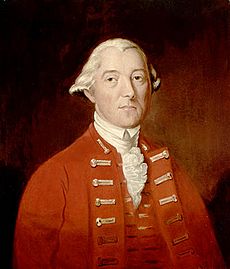
General Carleton began preparing Quebec's defenses as soon as he heard about the American invasion. He declared martial law and called up the local militia. He gathered his small number of regular British soldiers. He also formed a new regiment called the Royal Highland Emigrants, made up of Scottish immigrants. Their commander, Allan Maclean, was a very determined officer.
Carleton also asked for more soldiers from British leaders in Boston, but they couldn't send any. Ships were blown off course, and the Saint Lawrence River was about to freeze, making it impossible to sail.
On November 3, news reached Quebec City that Arnold's tough march had succeeded. He was getting close to the city. The city's defenses were strengthened with more militia joining, bringing the total to about 1,200 men. Ships also arrived with more militia from other British colonies and some marines.
On November 10, Lieutenant Colonel Allan Maclean arrived with 200 of his Royal Highland Emigrants. They were experienced soldiers and their arrival greatly boosted the morale of the city's defenders. Maclean immediately took charge of the defenses.
Carleton Takes Command
After Montreal fell, Carleton escaped by ship and arrived in Quebec City on November 19. He quickly took command. He announced that any able-bodied man who didn't join the defense would be seen as a rebel. About 500 people, including British and Canadiens, joined the defense.
Carleton improved the city's defenses. He built barricades and fences along the river. He placed his soldiers and inexperienced militia in strong positions along the city walls.
Arnold's Difficult Journey to Quebec
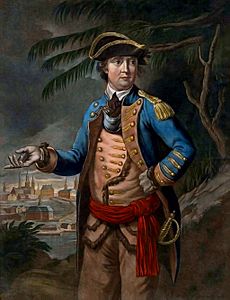
The British thought the wilderness of Maine was impossible to cross for an army. But General Washington believed it could be done. Arnold gathered 1,050 volunteers, mostly experienced woodsmen, and set off on September 5, 1775. His force included skilled riflemen from Pennsylvania and Virginia led by Captain Daniel Morgan.
The journey was much harder than expected. It was about 300 miles, not 180, and the land was very tough. They faced icy rains, sickness, and rivers full of obstacles. Bad weather and damaged boats ruined much of their food. About 500 men turned back or died. The remaining men were starving by the time they reached the first French settlements in early November. They were so hungry they ate their leather shoes and belts.
On November 9, the 600 survivors of Arnold's march reached Point Levis, across the St. Lawrence River from Quebec City. Despite their poor condition, Arnold immediately tried to find boats to cross. A storm delayed them for three days. Finally, on November 13, about 500 men crossed the river in canoes and landed near the city walls.
Arnold's troops were very poorly equipped. They had no cannons, few bullets, and many of their guns didn't work. Their clothes were in rags. Even so, Arnold demanded the city surrender. His messengers were shot at, showing the British would not give up. Arnold realized he couldn't take the city by force. He tried to blockade it from the west, but his men were too few and too weak. On November 18, they moved further upriver to wait for Montgomery.
Montgomery Joins Arnold
On December 1, General Montgomery arrived at Pointe-aux-Trembles. He brought about 300 soldiers, some artillery, and winter clothing for Arnold's men. He also had about 360 men recruited from Canada. Arnold was not popular with his men, and some asked to serve under Montgomery instead.
The combined American forces then moved to Quebec City and began a siege on December 6. Montgomery sent letters to Carleton demanding surrender, but Carleton refused and burned the letters. The Americans also sent messages to the people inside the city, hoping they would help.
The British continued to strengthen their defenses. Montgomery used his cannons to bombard the city, but it didn't do much damage. Many of Montgomery's soldiers had enlistments (their time serving) ending on December 31. He was under pressure to take the city before his army shrank. He believed his only chance was to attack during a snowstorm at night, hoping to climb the walls without being seen. On Christmas Day, Montgomery told his army his plan to attack Quebec City.
A snowstorm arrived on December 27, but then it stopped, so Montgomery called off the attack. A soldier deserted and told the British the American plan. So, Montgomery made a new plan. He would have two fake attacks on the western walls, while two main attacks would hit the lower town. Arnold would lead one attack from the north, and Montgomery would lead another from the south. They would meet in the lower town and then try to take the upper city. On December 30, a heavy snowstorm began, and Montgomery ordered the attack for that night.
The Battle Begins
Montgomery's Attack
The storm was a blizzard, making it hard to see and move. Montgomery led his men down a steep, snowy path towards the city's outer defenses. Church bells rang, warning the British defenders. Montgomery's men cut through two wooden fences. He then led 50 men down a street towards a two-story building that was part of the city's defenses. It was a small fort with 39 local militia and 9 sailors.
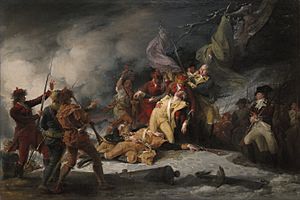
As Montgomery led his men forward, the defenders opened fire from close range. Montgomery was killed instantly by a cannon blast, and most of the men around him were also killed or wounded. The few survivors fled back. Montgomery's body was left behind, and the attack from his side failed.
Arnold's Attack
While Montgomery attacked, Arnold led his main force towards the barricades at the northern end of the lower town. His group included 30 riflemen and artillerymen, followed by more riflemen, New England volunteers, and some Canadiens and Native Americans who had joined them.
They passed some outer gates without being seen. But as they moved around the Palace Gate, heavy fire came down from the city walls. Muskets fired, and grenades were thrown. The sled carrying their cannon got stuck in the snow and was left behind. Arnold ordered his men to run to the docks, which were not behind the walls. But they got lost in the unfamiliar streets and the blizzard.
They advanced down a narrow street and came under fire again. They faced a barricade defended by 30 Canadien militia with three small cannons. Arnold had planned to use his own cannon, but it was lost. He ordered a direct attack. As he was getting his men ready, Arnold was shot in the leg and wounded. He had to be carried away, and Daniel Morgan took command.
Morgan, a tough leader, personally led the charge. He tried to climb a ladder over the barricade but was knocked down. On his second try, he made it over. After a short fight, the 30 militia surrendered.
Under Morgan's command, they captured the barricade. But they had trouble moving forward because of the narrow, twisting streets and wet gunpowder, which made their guns useless. Morgan's men also stopped to wait for the rest of the army, causing a 30-minute delay. Meanwhile, Carleton realized the other attacks were fake and sent more soldiers to the lower town.
A British force of 500 soldiers came out of the Palace Gate and took back the first barricade. This trapped Morgan and his men inside the city. Many of the American guns wouldn't fire because of the damp powder. As the fighting continued, the Americans ran out of ammunition. With no way to escape and under heavy fire, Morgan and his men surrendered. The battle was over by 10 AM. Morgan was the last to surrender. He gave his sword to a Catholic priest instead of a British officer.
The British found paper streamers on the American soldiers' hats that read "Liberty or Death!" This was the first major defeat for the Continental Army. Carleton reported 30 Americans killed and 431 captured. Arnold reported about 400 missing or captured, with 60 killed. British casualties were very low: 5 killed and 14 wounded.
General Montgomery's body was found by the British on New Year's Day 1776. He was given a simple military funeral. With the losses and soldiers leaving as their enlistments ended, Arnold was left with only 600 men to besiege Quebec City.
The Siege of Quebec
Arnold refused to give up, even though he was outnumbered. He continued to besiege Quebec City through the winter. The siege didn't affect the city much, as Carleton claimed they had enough supplies to last until May. Arnold's artillery shelling caused some damage to civilian homes but didn't weaken the British defense.
Disease, especially smallpox, greatly weakened the American besiegers. Many soldiers got sick because they were exposed to infected civilians released from Quebec. The Americans also struggled to get supplies. They had to pay with paper money, which the local habitants didn't want, preferring coins. This, along with news of anti-Catholic actions by another American general in Montreal, made the Americans very unpopular with the local people.
In early April, General John Thomas took command of the American forces. He saw that the siege could not continue. On May 6, a small British fleet arrived with 200 fresh soldiers. This made the Americans hurry their retreat. The retreat turned into a panicked escape when Carleton marched his fresh forces out of the city to face the disorganized Americans. The American forces, suffering from smallpox (which killed General Thomas), retreated all the way back to Fort Ticonderoga.
What Happened Next
After the Americans were driven out, Carleton ordered a check to find out which Canadiens had helped the Americans. About 757 people were identified. Carleton was somewhat forgiving at first, but later, punishments became harsher, including forced labor to repair damage. This made people less likely to openly support the Americans. However, some Canadiens continued to fight for the American Revolution.
Between May and June 1776, nearly 40 British ships arrived in Quebec City. They brought over 9,000 soldiers, including about 4,000 German soldiers (called Hessians) who fought for the British. These troops stayed in Quebec for the winter, which put a lot of pressure on the local population.
After the American victory at the Battle of Saratoga in 1777, the American Congress thought about invading Canada again. But they realized it would take too many soldiers and supplies, which they didn't have. Quebec City was a very strong fortress, and it would be too hard to capture. The idea of invading Canada was discussed until 1780, but no new invasion happened.
During the peace talks in Paris in 1782–83, the Americans asked for Canada to become part of the United States. But since they didn't control Canada at the time, the British refused. If the Americans had won the Battle of Quebec and still held Canada, the outcome of these talks might have been different.
Today, three units of the United States Army National Guard can trace their history back to the American units that fought in the Battle of Quebec.
Timeline of Key Events
- April 1775: American Revolutionary War begins.
- May 10, 1775: Ethan Allen and Benedict Arnold capture Fort Ticonderoga.
- June 9, 1775: General Guy Carleton proclaims martial law in Quebec.
- June 27, 1775: Second Continental Congress authorizes the invasion of Quebec.
- September 5, 1775: Benedict Arnold begins his march through the Maine wilderness.
- September 16, 1775: Richard Montgomery takes command of the American Northern Department forces.
- November 3-4, 1775: British reinforcements arrive in Quebec City.
- November 9, 1775: Arnold's surviving forces arrive at Point Levis, opposite Quebec City.
- November 10, 1775: Lieutenant Colonel Allan Maclean arrives in Quebec City with Royal Highland Emigrants.
- November 13, 1775: Montgomery captures Montreal; Arnold's men cross the St. Lawrence River to the Plains of Abraham.
- November 18, 1775: Arnold moves his forces to Pointe-aux-Trembles to await Montgomery.
- November 19, 1775: General Guy Carleton arrives in Quebec City and takes command of the defense.
- December 1, 1775: Montgomery arrives at Pointe-aux-Trembles, joining Arnold's forces.
- December 6, 1775: American forces begin the siege of Quebec City.
- December 25, 1775: Montgomery announces his plan for a direct assault.
- December 30, 1775: A heavy blizzard begins, prompting Montgomery to order the attack.
- December 31, 1775 (early morning): The Battle of Quebec is fought. General Montgomery is killed, Benedict Arnold is wounded, and American forces are defeated.
- January 1, 1776: General Montgomery's body is recovered by the British.
- January 4, 1776: Montgomery is given a military funeral by the British.
- Winter 1775-1776: Arnold maintains an ineffectual siege of Quebec City, facing disease and dwindling supplies.
- May 6, 1776: British reinforcements arrive in Quebec City, leading to the American retreat.
- May 22, 1776: Carleton orders a survey to identify Canadian supporters of the American expedition.
- May-June 1776: More British and German troops arrive, solidifying British control.
- 1777: Many of these troops are deployed for Burgoyne's campaign in New York.
- 1782-1783: During peace negotiations, American request for Canada is denied.
See also


